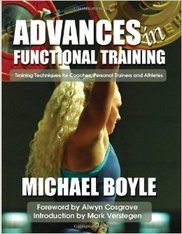 Advances in Functional Training Michael Boyle Santa Cruz, California On Target Publications, 2010 315 pages Authored by one of North America's pioneers of strength and conditioning, Advances in Functional Training is a book written primarily for coaches, trainers, and athletes. With an obvious emphasis on function, one would be hard pressed to withhold this text from the rehabilitation professional as well, since many of the concepts discussed look at applied movement as it pertains to sport. Advances in Functional Training is divided into eleven sections:
While many of the above chapters pertain specifically to strength training and athletic development, there is certainly no shortage of crossover to the field of sport medicine. Touching on specific topics such as core stability and sports hernias, among others, Boyle provides the reader with sound strategies for training around injuries. In fact, his "sports hernia" section really opened my eyes to effective rehabilitation and I've been treating hockey players for quite some time. Regardless, many of the training principles incorporated in this text can easily be applied in the rehab setting, even those principles surrounding periodization. Now many of you in the field of sport medicine may be quick to ignore this text simply because of its title, but I can assure you that many of its concepts are relevant to your everyday practice. For those of you unaware, prior to full time strength training, Boyle previously worked an athletic trainer so he certainly understands the nature of injuries sustained in sport. Now I, myself, am a big believer of training heavy in rehabilitation but for those of you comfortable with yellow resistance bands and heat packs, you're more than welcome to forego this text. And for those of you interested in taking your rehabilitation skills to the next level, I highly suggest you get your hands on a copy. Think about it, how fun would it be to differentiate yourselves with the next clinic by using kettlebells, the TRX and valslides/slideboards in your practice? You really don't need much to rehab your patients effectively and efficiently and you certainly do not need a large budget for useless exercise machines that take up enormous amounts of space. If you are doubtful, just ask my interns. But you do have a great opportunity to change the way your current rehabilitation programs are being implemented and Advances in Functional Training is but one important resource to help you do so. Better yet, get yourself a membership to strengthcoach.com
0 Comments
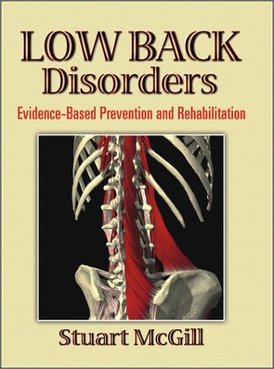 An oldie, but a goodie. This review pertains to McGill's Low Back Disorders (1st edition). It was written by Angela Regier Cubos, DC several years back, but worth the read. Low Back Disorders: Evidence-Based Prevention and Rehabilitation Stuart McGill Human Kinetics Inc., 2002 295 pages This book attempts to give the reader a more in-depth understanding of the workings of the lumbar spine as it pertains to injury and rehabilitation. It is geared towards the more academically inclined individual, with a basic understanding of the anatomy and biomechanics of the low back. The author uses the most current and relevant scientific evidence to develop rehabilitation strategies for common low back pain, while highlighting common misconceptions that are often encountered in rehabilitation. The book is divided into 3 distinct sections, each with its own focus. Part I provides a foundation for the remainder of the book by: giving an introduction to the issues surrounding low back disorders in society; highlighting the current knowledge regarding the epidemiology of low back pain; giving an in-depth description of the functional anatomy of the lumbar spine; as well as delving in to the mechanics of the lumbar spine, both in a normally functioning and injured state. Part II focuses on injury prevention strategies. Various guidelines for risk assessment are discussed that can be applied to both the occupational and/or athletic setting. The author then provides various strategies that should be employed by both the occupational worker as well as the athlete in order to reduce the occurrences of low back injuries, such as proper lifting techniques and training strategies. This section ends with an in-depth discussion of the use of back belts both in the workplace and for the athlete as a means of treating and preventing low back pain. Finally, Part III uses the foundational scientific knowledge gained in the preceding chapters to introduce rehabilitation strategies for low back disorders. This section explains how to properly assess each individual to determine the type of rehab strategies to employ, and then proceeds to explain the best exercises to use in order to train and strengthen the lumbar spine. The author provides exercises of varying degrees of difficulty in order to encompass a wide range of patients, up to, and including, the high-performance athlete. He demonstrates the need to include these exercises that provide maximal opportunity for strengthening, yet minimal opportunity for injury in any management program, and provides the research to support this. Overall, McGill does an impeccable job of presenting the reader with a concise overview of the overwhelming topic of low back injury and rehabilitation. Tackling such an enormous issue in the scientific and thorough manner demonstrated here, reserves this book for those who already have a foundation in anatomy, biomechanics, and treatment strategies for the low back. Despite the plethora of charts and experimental data presented throughout the book, the reader feels well versed at the conclusion of the text to accurately assess the low back, as well as implement safe and effective rehabilitation strategies for a wide range of patients. This book is a must-read for any manual therapist who will be encountering the common complaint of low back pain in practice. The more recent version of Low Back Disorders (2nd Edition) is available through my Amazon library by clicking on “Educational Resources” above. 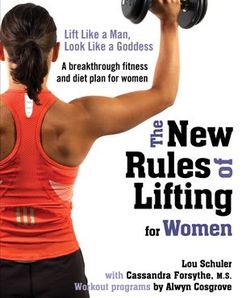 This review was written by Angela R. Cubos, DC The New Rules of Lifting for Women Lou Schuler with Cassandra Forsythe New York, NY Penguin Group (USA) 258 pages Tired of doing the same old routine in the weight-room? Not getting the most out of your workouts? Still stepping on the scale and seeing the same number as before? As the old saying goes: “If you always do what you’ve always done, you’ll continue to get the results you’ve always got.” Ready for a change? Then this book is for you. The New Rules of Lifting for Women, by Lou Schuler, is a book designed for the woman looking to gain a deeper understanding of effective training methods in order to transform her body composition to meet her training goals. Author Lou Schuler highlights many common myths prevalent within the female weight-lifting community, which are contributing to a lack of results despite hours of training. Using humorous examples of the various training deficiencies he has observed over the years ("unless you're an extreme genetic outlier, you can't get too bulky!"), he educates the reader on the most effective way she should be training if she aspires to “look like a goddess”. The book is comprised of three parts. Part 1, Behind the Cover Lines, builds a foundation for the rest of the chapters by educating the reader on the benefits of effective strength training. Part 2, You Aren’t What You Don’t Eat, contains invaluable information on proper nutrition for strength-training women, to aid in the weight-loss process, complete with detailed recipes and meal plans. Finally, part 3, Resistance is Vital, contains a detailed, progressive training program complete with pictures and exercise descriptions, based upon the information presented in the preceding chapters. I found this book motivational and encouraging, as it makes the reader feel empowered to take command of her own workouts. The workout programs are laid out step-by-step for six months, and contain a balance of both challenging, yet familiar exercises, while the nutritional section contains tasty, healthy recipes that go beyond grilled chicken with steamed vegetables. Overall, a must read – before your next workout! 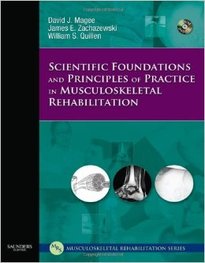 Scientific Foundations and Principles of Practice in Musculoskeletal Rehabilitation David J. Magee, James E. Zachazewski, William S. Quilllen (editors) St. Louis, MO Saunders, 2007 701 pages Scientific Foundations and Principles of Practice in Musculoskeletal Rehabilitation is one of a three-volume series by Magee, Zachazewski, and Quillen titled Musculoskeletal Rehabilitation Series and keystoned by the 5th edition of Magee’s classic text Orthopaedic Physical Assessment. Scientific Foundations and Principles of Practice, in particular, is also part one of a follow up to the decade old Athletic Injuries and Rehabilitation, primarily edited by Zachazewski, that has acted as one of the cornerstones of contemporary sport medicine. This text, aimed at providing practicing clinicians with the most up-to-date literature for guidance with therapeutic intervention, is divided into two sections. Section I, Scientific Foundations, is inclusively geared toward providing the framework of musculoskeletal rehabilitation based upon an understanding of the body’s response to injury and exercise. The pathophysiology and mechanics of the various types of human tissues, as well as the effect of pharmacology and aging on the human body, underlie this section that serves as a foundation for understanding the mechanism of injury and disease and essential role of rehabilitation. Section II, Principles of Practice, has a slightly broader scope than the previous as it provides an evidence-based, conceptual framework from which practitioners can develop strategies for proper clinical evaluation and management. Wellness, neuromuscular control, cardiovascular conditioning, and the kinetic chain are covered in this section and can be considered as staples when developing intervention strategies. Further, Magee et al. incorporate chapters pertaining to orthopaedic testing, diagnostic imaging, fracture management and functional testing to provide clinicians with necessary information to guide in the clinical decision-making process. As a component of the Musculoskeletal Rehabilitation Series, Scientific Foundations and Principles of Practice provides the clinician with blueprint information to which he or she can refer when reviewing current and up-to-date literature. To supplement its intensive text, this book liberally incorporates ample tables, pictures, and diagrammatic illustrations, thereby rendering the ability for a practicing clinician to follow the comprehensive information with relative ease. For the advanced student, this book can assist in making a seamless transition into clinical practice. However, for a book designed as a follow up to one originally geared towards the sport medicine demographic, the inclusion of clinical applications aimed at integrating a broader population often disrupts its continuity and focus. Nevertheless, the comprehensive nature of this text renders it a valuable fixture for any musculoskeletal rehabilitation practice. *Scientific Foundations and Principles of Practice is available through my Amazon library by clicking on "Educational Resources" above 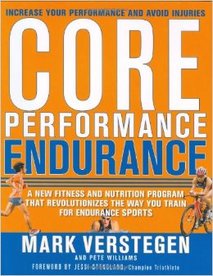 Core Performance Endurance Mark Verstegen and Pete Williams New York, USA Rodale Inc, 2007 238 pages Core Performance Endurance, co-authored by one of the pioneers of "functional training", Mark Verstegen, is a book written primarily for the endurance demographic with an objective of improving performance and avoiding injuries. The foundation of this text lies in Verstegen's first book, Core Performance, but expands further based on the consideration of the typical high-volume and -intensity training programs of endurance athletes. Core Performance Endurance is divided into four parts; 1) The Core Endurance Mindset; 2) Core Endurance Movement; 3) Core Endurance Nutrition; and 4) The Core Endurance Workout. The Core Endurance Mindset lays the foundation for this book through a brief explanation of the importance of elasticity and tissue tolerance within the body and an interactive, reader-engaging biomechanical self-assessment. Core Endurance Movement builds upon this new "mindset" through an explanation of Pillar Strength, an introduction of "power endurance" (which I essentially interpret as "efficiency"), a look into TRUE energetics, and the importance of regenerating the body. While I respect the content of this text in its entirety, the heart and soul of Core Performance Endurance lies in this section (part 2) through its potential to stimulate thought in the "experienced" athlete and pull him or her out of his/her comfort zone and into a new, more effective training mentality. While the majority of Verstegen and Williams' nutritional advice can be found in their book Core Performance Essentials, part 3 of this book, Core Endurance Nutrition addresses strategies that endurance athletes can utilize in their quests for performance. Specifically, Verstegen and Williams address the high importance of carbohydrates and protein, as well as the role of specific fats and nutritional supplements in athletes, but perhaps more importantly, they address meal timing as it pertains to improved performance. Examples of specific meals and food sources are included here. Finally, part 4 introduces The Core Endurance Workout, a regime built around power, strength, and regeneration. Unless the athlete is a coached professional or has experience in the field of contemporary strength and conditioning, it is unlikely he or she will be familiar with this approach to training. The workout contained within looks nothing like your conventional gym workout (bodybuilding OR team sport), nor does it resemble a program commonly seen in rehabilitation settings. The exercises incorporated are detailed and geared toward improving both biomechanical efficiency AND performance. Progressions are included and transition the athlete from day one, straight through to race day. While the world of sports performance and injury prevention continually evolve with contemporary research, Core Performance Endurance indeed provides a valuable educational resource to athletes of all levels and abilities. For the coach or sport medicine professional working with this demographic, this text also provides excellent insight into the role movement efficiency plays on various aspects of running, triathlon, and other similar sporting endeavors. 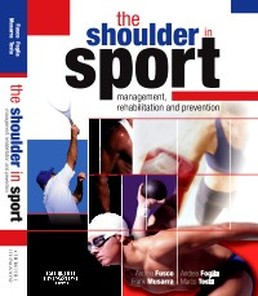 The Shoulder in Sport: Management, rehabilitation, and prevention Andrea Fusco, Andrea Foglia, Frank Musarra, and Marco Testa Bologna, Italy Churchill Livingstone, 2008 331 pages The Shoulder in Sport is a specialty text, authored by expert physiotherapists, Fusco, Foglia, Musarra, and Testa. This book illustrates a multidisciplinary approach to the shoulder health of athletes and through its specific application to sport, is a valuable educational tool for all professionals involved in sport injury management. The Shoulder in Sport is divided into 5 sections. Section I, Functional Anatomy and Recent Biomechanical Discoveries is the blueprint of this book, detailing the normal structures, congenital anomalies, and vital mechanics of the complete shoulder system. Section II, Pathology, Clinical Aspects and Diagnostic Imaging systematically and comprehensively includes the components of shoulder injury and dysfunction in sport. Its first two chapters cover the two most common pathologies (shoulder instability and impingement syndromes) and are followed by the epidemiology of shoulder lesions in sport, specialist examination, and diagnostic imaging. The final chapter in this section pertains to functional examinations and describes a thorough approach for clinical shoulder evaluation in manual therapy. Section III, Surgical Treatment, details the indications, methods, and solutions of operative management in sport-related shoulder pathology. Section IV, Rehabilitation, Training and Prevention incorporates the progression of rehabilitation principles with functional training considerations and transitions its chapters into a practical manual for the sports specific demographic. Lastly, Section V, Current Trends in Surface Electromyography, outlines the theory, methodology, and practical application of surface EMG in sport injury prevention, as well as its potential role in sport injury management. The Shoulder in Sport is rich in content and up to date, and excludes very little in the medical management of shoulder injuries in sport. Supported by dozens of articles per chapter, this text can be utilized by many different professionals to gain a better conceptualization of this functionally important anatomical region. For the clinician, a broader knowledge and understanding of the etiology of shoulder pain in sport is given. For the surgeon, a better appreciation of the rehabilitation principles and determinants is provided. Lastly, for the rehabilitation specialist, a complete surgical picture and the application of electromyography are rendered. Irrefutably, The Shoulder in Sport is an educational resource highly recommended for the sport medicine community. 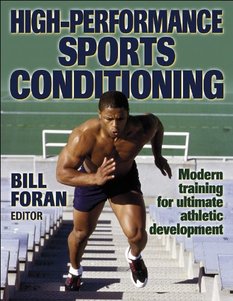 High-Performance Sports Conditioning Bill Foran (editor) Champaign, IL Human Kinetics, 2001 367 pages High-Performance Sports Conditioning by Bill Foran (editor) was on of the first books aimed at providing a comprehensive insight into functional training. Recognizing that traditional sports conditioning provided limited contributions to athletes’ abilities to excel in sports, Foran assembled a panel of scientists and practitioners to ‘present the present and future of sports conditioning: functional training’. This book was divided into two parts; 1) developing the sports performance foundation; and 2) developing a sports performance training program. The first part covered all variables of sports conditioning. Chapters one to three addressed general precursors to any performance conditioning program: establishing a solid fitness base, baseline fitness testing, and performance flexibility. The latter chapters addressed conventional variables of sports conditioning: muscular strength and endurance, power, quickness, balance and core stability, agility and coordination, acceleration and speed, and aerobic capacity. Each chapter was written by a ‘specialist’ in the field and, through their experience and research, provides both a theoretical and practical viewpoint to each concept. Part 2 of this text advanced beyond the above principles of sports conditioning and addresses arguably the most important concept of sports conditioning – periodization. In this section, specific sports were evaluated and, sport-specific skills and periodization methods were provided. A single chapter (written by Tudor Bompa) was devoted entirely to the theoretical principles of periodization and provided readers with a thorough foundation upon which future training programs may be designed. Finally, the last chapter of this book addressed the link and transition between post-rehabilitation conditioning and performance training. This chapter provided the conditioning specialist with a general knowledge base that could be utilized when guiding athletes in their return to athletic competition. Despite Foran’s attempt to provide a comprehensive, yet novel reference for the field of sports conditioning, this book found itself lost between theory and practice. Lacking in-depth scientific principles, High-Performance Sports Conditioning failed to provide both the foundation upon which exercise science is grounded, and the battery of training techniques necessary for exercise prescription to be developed. Further, while references were listed at the end of this text, many chapters seem to have been written based on anecdotal evidence and personal experience. Finally, while the inclusion of multiple "experts” as chapter authors provided a variety of ideas, a disconnect in theory and consistency seemed evident. Overall, this book would still be a useful resource for personal trainers or health practitioners interested in the sporting realm. However, for conditioning specialists working with higher-level athletes, this book failed to be the ultimate resource. 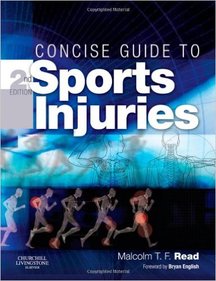 Concise Guide to Sports Injuries (2nd Edition) Malcolm T.F. Read London, UK Churchill Livingstone, 2008 380 pages Consideration for differential diagnoses is an essential practice of primary healthcare professionals and the field of sport medicine applies the principles of primary healthcare to athletic training, development, and competition. Concise Guide to Sports Injuries (2nd Ed.) by Read is handy tool for professionals interested in the management of sports injuries. Concise Guide is organized into 21 chapters and is arranged by the anatomical region of pain and dysfunction. The preface is an introduction to this book but also doubles as an instruction manual for its use. The beginning of each chapter includes map-like diagrams to introduce the reader to the potential differential diagnoses for that region. For each particular injury and disease, Read includes the general findings of the history and physical examination, possible etiological causes, pertinent investigations (diagnostic imaging) necessary for diagnoses, and potential treatment strategies. Each section also includes a “comments” section where the author contributes with input based on his experience in practice. The last two chapters of this book pertain to “Rehabilitation and training with an injury” and “Team doctoring”. The rehabilitation chapter transitions from the general principles of rehabilitation, through the various stages and types of rehabilitation, and into “Rehabilitation Ladders”, general and sport-specific templates that can be used to progress athletes back into sport. Read’s team doctor chapter introduces those medical professionals who may have the responsibility to travel with teams to some of the physiological and practical problems that he or she might be faced with. Topics ranging from altitude sickness to haemoglobinuria and treatment under exemption (TUE) are covered in this chapter. Perhaps the most valuable component of this text is the glossary. This expanded reference section is easily accessible, and provides the reader with a brief explanation, or the “how, what, and why” of each orthopaedic test, sport injury, and physical disease mentioned. Readers will often find themselves referring to this section for a greater understanding of the content of this dynamic text. This book is a follow up to Read’s 1st edition (2000) and is a practical guide for the doctor or rehabilitation specialist working on the field or in a sports oriented clinic. Unfortunately, certain topics (concussions and low back rehabilitation) included management protocols with outdated references, considering the contributions made to the literature in recent years. Although, it may not be used as a textbook of sports medicine, Concise Guide can be a rather easily accessible reference text for the variety of problems faced by medical professionals in sport. |
